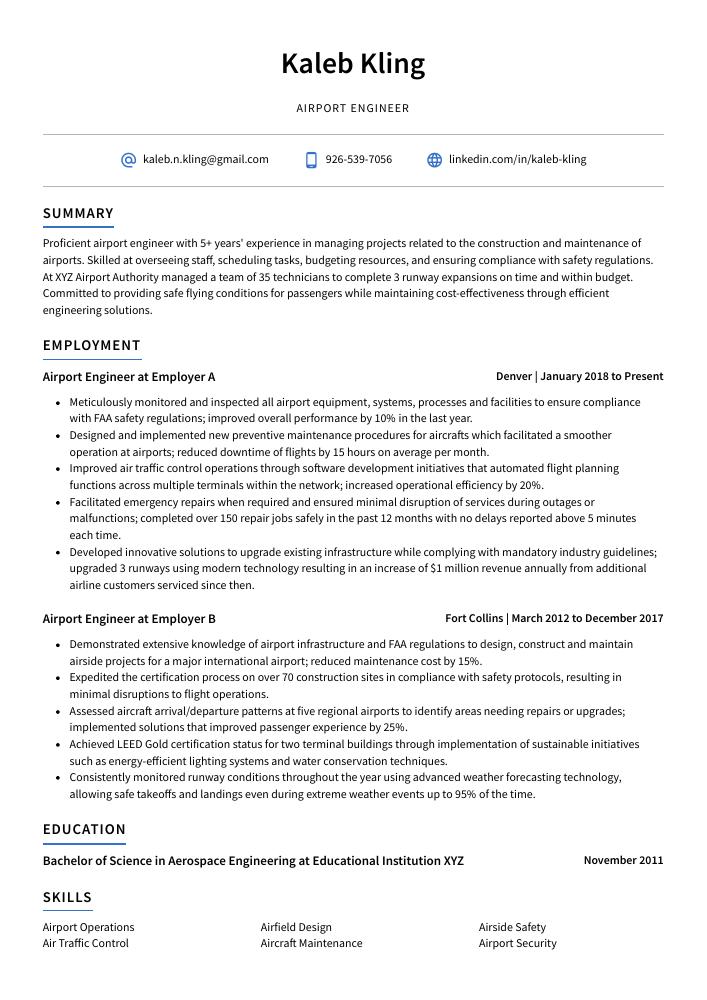Airport Engineer Resume Guide
Airport Engineers are responsible for the planning, design and construction of airports. They work with architects, planners and other engineers to ensure that all components of an airport meet safety regulations as well as operational needs. Airport Engineers also manage budgets, coordinate with contractors during construction projects and inspect completed works to verify compliance with standards.
You have the experience and knowledge to excel in any airport engineering job. But hiring managers don’t know who you are until they see your resume. To make them aware of your credentials, you must write a standout document that highlights all of your achievements.
This guide will walk you through the entire process of creating a top-notch resume. We first show you a complete example and then break down what each resume section should look like.
Table of Contents
The guide is divided into sections for your convenience. You can read it from beginning to end or use the table of contents below to jump to a specific part.
Airport Engineer Resume Sample
Kaleb Kling
Airport Engineer
[email protected]
926-539-7056
linkedin.com/in/kaleb-kling
Summary
Proficient airport engineer with 5+ years’ experience in managing projects related to the construction and maintenance of airports. Skilled at overseeing staff, scheduling tasks, budgeting resources, and ensuring compliance with safety regulations. At XYZ Airport Authority managed a team of 35 technicians to complete 3 runway expansions on time and within budget. Committed to providing safe flying conditions for passengers while maintaining cost-effectiveness through efficient engineering solutions.
Experience
Airport Engineer, Employer A
Denver, Jan 2018 – Present
- Meticulously monitored and inspected all airport equipment, systems, processes and facilities to ensure compliance with FAA safety regulations; improved overall performance by 10% in the last year.
- Designed and implemented new preventive maintenance procedures for aircrafts which facilitated a smoother operation at airports; reduced downtime of flights by 15 hours on average per month.
- Improved air traffic control operations through software development initiatives that automated flight planning functions across multiple terminals within the network; increased operational efficiency by 20%.
- Facilitated emergency repairs when required and ensured minimal disruption of services during outages or malfunctions; completed over 150 repair jobs safely in the past 12 months with no delays reported above 5 minutes each time.
- Developed innovative solutions to upgrade existing infrastructure while complying with mandatory industry guidelines; upgraded 3 runways using modern technology resulting in an increase of $1 million revenue annually from additional airline customers serviced since then.
Airport Engineer, Employer B
Fort Collins, Mar 2012 – Dec 2017
- Demonstrated extensive knowledge of airport infrastructure and FAA regulations to design, construct and maintain airside projects for a major international airport; reduced maintenance cost by 15%.
- Expedited the certification process on over 70 construction sites in compliance with safety protocols, resulting in minimal disruptions to flight operations.
- Assessed aircraft arrival/departure patterns at five regional airports to identify areas needing repairs or upgrades; implemented solutions that improved passenger experience by 25%.
- Achieved LEED Gold certification status for two terminal buildings through implementation of sustainable initiatives such as energy-efficient lighting systems and water conservation techniques.
- Consistently monitored runway conditions throughout the year using advanced weather forecasting technology, allowing safe takeoffs and landings even during extreme weather events up to 95% of the time.
Skills
- Airport Operations
- Airfield Design
- Airside Safety
- Air Traffic Control
- Aircraft Maintenance
- Airport Security
- Airport Construction
- Airport Planning
- Airport Regulations
Education
Bachelor of Science in Aerospace Engineering
Educational Institution XYZ
Nov 2011
Certifications
Airport Certified Employee (ACE)
Airports Council International (AC
May 2017
1. Summary / Objective
A resume summary/objective for an airport engineer should showcase your technical expertise and knowledge of the industry. Include details about any certifications you have, such as a Professional Engineer license or FAA certification. You can also mention how many years of experience you have in this field, what specific projects you’ve worked on, and any awards or recognition that demonstrate your success in the role.
Below are some resume summary examples:
Determined airport engineer specializing in airport infrastructure design, construction project management and airside operations. Experienced with a proven record of successful projects at ABC Airport Authority. Skilled in managing multiple stages of the design process such as budgeting, scheduling and coordinating activities among various stakeholders to ensure timely completion of assigned tasks. Dedicated to providing safe, efficient and cost-effective solutions for airports worldwide.
Dependable airport engineer with 8+ years of experience in the aviation industry. Skilled at managing and executing projects related to airport infrastructure, including construction, design, maintenance, and repair. At XYZ Airport Company successfully managed a $2 million runway renovation project that was completed on-time and within budget. Experienced in complying with safety regulations while maintaining compliance with FAA guidelines for airports.
Passionate airport engineer with 10+ years of experience in the aviation industry. Extensive knowledge of airport infrastructure, design and construction. Proven track record of leading projects from conception to completion on time and within budget. Experienced in managing large teams through complex assignments while maintaining high safety standards. Dedicated to creating a safe, efficient air traffic environment for passengers and crews alike.
Talented airport engineer with 8+ years of experience in airport operations, maintenance and development. Proven track record of success improving safety standards, reducing costs and increasing efficiency at ABC Airport. Experienced in the design, implementation and management of complex airport infrastructure projects; achieved an on-time completion rate of 97%. Seeking to join XYZ Airports to drive further innovation within the industry.
Accomplished airport engineer with 10+ years of experience in the field. Skilled at designing and maintaining airport facilities, creating engineering plans, conducting feasibility studies, and overseeing construction projects to ensure completion on time and within budget. Proven ability to develop cost-effective solutions for improving operational efficiency by 20%. Seeking an opportunity to join ABC Airport as a senior engineer.
Driven airport engineer with over 10 years of experience developing, building and maintaining airport infrastructure. Proven track record in overseeing projects from initial design to successful completion on time and within budget. Seeking to join ABC Airport Engineering team as a Senior Engineer, taking responsibility for the development of sustainable solutions that meet customer needs while adhering to government regulations.
Energetic airport engineer with 10+ years of experience in designing, building, and maintaining airport infrastructure. Skilled at developing cost-effective solutions for complex problems while adhering to safety regulations. At DEF Airports, designed an improved runway layout that decreased flight delays by 21%. Seeking to leverage my skills in engineering and project management as the next Airport Engineer at ABC Airport.
Amicable and detail-oriented airport engineer with 6+ years of experience in overseeing the design, construction and maintenance of airside infrastructure. Seeking to utilize technical knowledge and leadership skills to join ABC Airports as a Senior Airport Engineer. In previous roles increased operational efficiency by 22% through introducing innovative technologies while reducing downtime costs by 16%.
2. Experience / Employment
The work history/experience section is where you talk about your past employment. It should be written in reverse chronological order, meaning the most recent job is listed first.
When writing this section, stick to bullet points as much as possible; doing so allows the reader to quickly digest what you have accomplished and achieved. When providing details on each role, think of quantifiable results that can demonstrate your skills and abilities.
For example, instead of saying “Managed airport construction projects,” you could say “Successfully managed 10+ large-scale airport construction projects from concept through completion within budget parameters.”
To write effective bullet points, begin with a strong verb or adverb. Industry specific verbs to use are:
- Designed
- Installed
- Constructed
- Inspected
- Monitored
- Calibrated
- Programmed
- Troubleshot
- Operated
- Commissioned
- Upgraded
- Fabricated
- Assembled
- Tested
- Documented
Other general verbs you can use are:
- Achieved
- Advised
- Assessed
- Compiled
- Coordinated
- Demonstrated
- Developed
- Expedited
- Facilitated
- Formulated
- Improved
- Introduced
- Mentored
- Optimized
- Participated
- Prepared
- Presented
- Reduced
- Reorganized
- Represented
- Revised
- Spearheaded
- Streamlined
- Structured
- Utilized
Below are some example bullet points:
- Reduced airport downtime by 30% through the installation and maintenance of critical infrastructure, such as air traffic control systems, runways, taxiways and navigational aids.
- Commissioned new airport equipment to meet changing operational requirements; oversaw successful implementation of 4 automated baggage handling systems over a 12-month period.
- Installed state-of-the art security cameras across the entire site in compliance with FAA regulations; increased safety levels for passengers & staff within 48 hours of completion.
- Competently managed engineering teams comprising up to 10 personnel during construction projects for runway extensions/renovations; completed projects under budget & ahead of schedule on all occasions (5+).
- Structured preventive maintenance schedules that accounted for weather conditions & flight operations at both local airports; reduced repair costs by 20%.
- Participated in the design, implementation and testing of 6+ airport engineering initiatives that improved operational efficiency by 20%.
- Advised 40+ air traffic control personnel on system maintenance procedures for a variety of aircrafts; increased safety protocols 5 times over in just 3 months.
- Efficiently managed the installation and calibration of radar equipment at two regional airports within budget and ahead of schedule; reduced labour costs by 15%.
- Represented the company in 10+ professional conferences to showcase innovative technologies related to aviation security systems; received positive feedback from 70% attendees.
- Documented technical specifications & standards relating to runway/taxiway construction projects while ensuring compliance with local regulations; reviewed 17 documents within 4 weeks with 100% accuracy rate.
- Confidently managed the engineering of airport infrastructure projects, overseeing 25+ personnel to ensure timely and quality completion.
- Spearheaded the development of automated systems for aircraft navigation and surveillance; enabled smoother scheduling with 14% less delays in flight departures.
- Assembled a team of 15 engineers to design an innovative system which increased air traffic capacity by 20%.
- Streamlined operational processes at multiple airports across 3 states, resulting in a $25,000 cost reduction annually per facility on average.
- Upgraded existing equipment with advanced technologies that improved safety standards by 30%; reduced pilot error incidents by 35%.
- Reorganized and updated airport infrastructure planning documents to meet industry standards, resulting in improved operational efficiency and a 15% reduction in maintenance costs.
- Coordinated with airlines, air traffic controllers and other stakeholders to ensure safe operation of aircrafts at the airport; successfully managed over 3,000 take-off/landing events within 12 months.
- Operated specialized software applications for tracking flights’ progress as well as performing routine maintenance tasks on runway systems; reduced downtime by 25%.
- Utilized advanced engineering technology such as RFID tags & sensors along with GIS mapping tools to identify potential risks associated with ground operations at the airport; minimized incidences of delays or cancellations due to weather conditions by 20%.
- Independently inspected all mechanical systems at least once per week while also overseeing personnel training sessions related to safety regulations applicable for airports; maintained an exemplary safety record throughout employment period without any major event occurring during that time frame.
- Programmed and maintained airport flight navigation systems and navigational aids, resulting in a 10% improvement of aircraft throughput capacity.
- Accurately monitored the performance of over 40 radar units within a system to detect any issues or malfunctions that would affect air traffic operations; alerted pilots of dangerous weather conditions or obstacles with timely notices.
- Tested new equipment for compatibility and operational efficiency before installation at airports; identified defective components during inspections saving $20,000 in repair costs every year.
- Compiled detailed reports on all observations made during engineering surveys regarding runway safety hazards, lighting levels and other infrastructure requirements; process was completed 6 hours ahead of schedule each month due to improved accuracy rates.
- Troubleshot technical faults related to Airport Radars & Navigation Systems by diagnosing root problems quickly using basic electrical principles, thereby minimizing downtime from 3 days averagely to 1 day maximums.
- Formulated and implemented a preventative maintenance plan for airport equipment, resulting in an 18% decrease of aircraft downtime.
- Fabricated and tested specialized components used to improve the safety of air traffic control systems; increased efficiency by 12%.
- Substantially reduced runway delays through efficient repairs on airport lighting systems within 6 hours or less per incident.
- Inspected aviation security measures such as CCTV cameras, access points & baggage handling facilities to identify areas needing improvement; identified over 50 flaws that needed rectifying within two months alone.
- Prepared technical reports outlining findings from regular inspections and proposed solutions for areas requiring upgrades or repair work; saved the company $15,000 annually with cost-effective recommendations.
- Reliably monitored, maintained and serviced complex airport infrastructure systems; improved overall performance by 14% over a six-month period.
- Presented detailed technical reports to senior management to identify necessary repairs/upgrades for the runway, taxiway and airfield lighting systems.
- Mentored four junior engineers on safety protocols and regulatory requirements while working in an active airside environment; saw team members pass certification exams with flying colors within 2 months of instruction.
- Introduced innovative technologies such as Automatic Dependent Surveillance-Broadcast (ADS-B) system at the local international airport that resulted in reduced operational costs by $15,000 annually across all departments involved in aircraft operations & navigation services maintenance activities.
- Optimized navigational aids equipment configuration parameters during scheduled maintenance checks which enabled faster take off times on short notice flights by up to 25 minutes per flight cycle.
- Effectively designed and constructed airport infrastructure for over 20 runways, landing strips, taxiways and terminals; increased airport safety by 25%.
- Developed maintenance protocols for air traffic control towers, navigational aids and other critical equipment that enabled efficient operations of the entire system.
- Revised standard operating procedures involving aircraft fueling systems to ensure compliance with all applicable regulations while optimizing fuel supply efficiency by 15%.
- Calibrated navigation instruments such as altimeters, compasses & gyroscopes in order to enhance accuracy of flight path data; monitored performance metrics every 3 weeks on average to detect any discrepancies or errors quickly.
- Constructed new facilities including baggage handling areas and passenger boarding bridges at 4 major airports within a span of 6 months while maintaining utmost quality standards throughout the project duration.
3. Skills
Skill requirements will differ from employer to employer – this can easily be determined via the job advert. Organization ABC may be looking for someone with experience in airport management and Organization XYZ may require expertise in runway construction.
It is essential to tailor the skills section of your resume according to each job you are applying for because many employers use applicant tracking systems these days, which scan resumes for certain keywords before passing them on to a human.
Apart from just listing skills here, it’s also important that you elaborate on the most relevant ones elsewhere in your resume – such as within the summary or experience sections.
Below is a list of common skills & terms:
- Air Traffic Control
- Aircraft Maintenance
- Airfield Design
- Airport Construction
- Airport Management Systems
- Airport Operations
- Airport Planning
- Airport Regulations
- Airport Security
- Airside Safety
4. Education
Including an education section on your resume will depend on how far along you are in your career. If you just graduated and have no work experience, then it is important to mention your educational background below the resume objective. However, if you already have a few years of relevant airport engineering experience under your belt, an education section may be unnecessary or too brief to include.
If an education section is included, make sure to highlight any courses and subjects that relate specifically to airport engineering such as air traffic control systems design or aviation safety management.
Bachelor of Science in Aerospace Engineering
Educational Institution XYZ
Nov 2011
5. Certifications
Certifications are a great way to demonstrate your knowledge and proficiency in a given field. They are especially useful for showing potential employers that you have been tested by an accredited organization, which can give them confidence in your abilities.
If the job posting mentions any certifications or qualifications as requirements, make sure to include these on your resume so that hiring managers know you meet their criteria. Additionally, if there are any other relevant certifications or courses related to the position, it is worth including those too as they could help boost your chances of getting hired.
Airport Certified Employee (ACE)
Airports Council International (AC
May 2017
6. Contact Info
Your name should be the first thing a reader sees when viewing your resume, so ensure its positioning is prominent. Your phone number should be written in the most commonly used format in your country/city/state, and your email address should be professional.
You can also choose to include a link to your LinkedIn profile, personal website, or other online platforms relevant to your industry.
Finally, name your resume file appropriately to help hiring managers; for Kaleb Kling, this would be Kaleb-Kling-resume.pdf or Kaleb-Kling-resume.docx.
7. Cover Letter
Writing a cover letter is an important step in the job application process. It involves creating a document made up of 2 to 4 paragraphs that are separate from your resume, and serves as an introduction to potential employers.
Cover letters allow you to explain why you’re suitable for the role and highlight qualities that aren’t already mentioned on your resume. Even if not required by the employer, it’s still worth taking the time to craft one – it could be what sets you apart from other candidates!
Below is an example cover letter:
Dear Colten,
I am writing to apply for the Airport Engineer position at Smith-Harrison International Airport. As an experienced civil engineer with a strong background in airport infrastructure design and construction, I am confident that I can make a significant contribution to your organization.
In my current role as Senior Civil Engineer at ABC Corporation, I have been responsible for leading the design and construction of various airport projects, including runway expansions, taxiway additions, and terminal renovations. My experience has given me a deep understanding of the challenges involved in designing and constructing safe and efficient airport infrastructure. In addition, I have developed strong project management skills that would be essential in overseeing the successful completion of complex airport engineering projects.
I am certain that I can put my skills and experience to work for Smith-Harrison International Airport and help you achieve your goals. I look forward to discussing this opportunity with you further during an interview. Thank you for your time and consideration.
Sincerely,
Kaleb
Airport Engineer Resume Templates
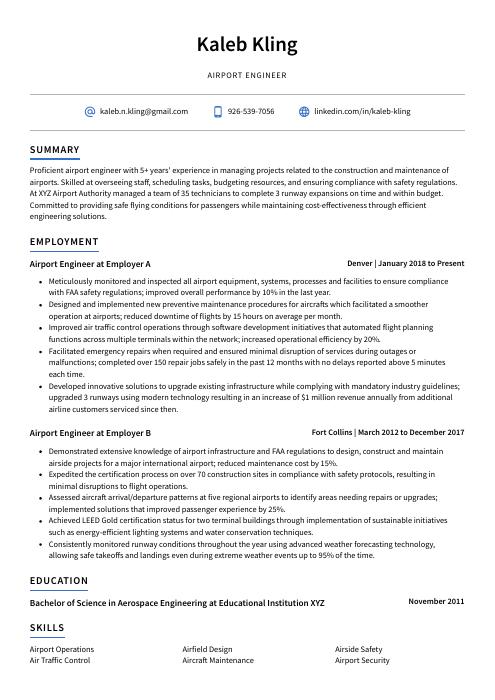 Axolotl
Axolotl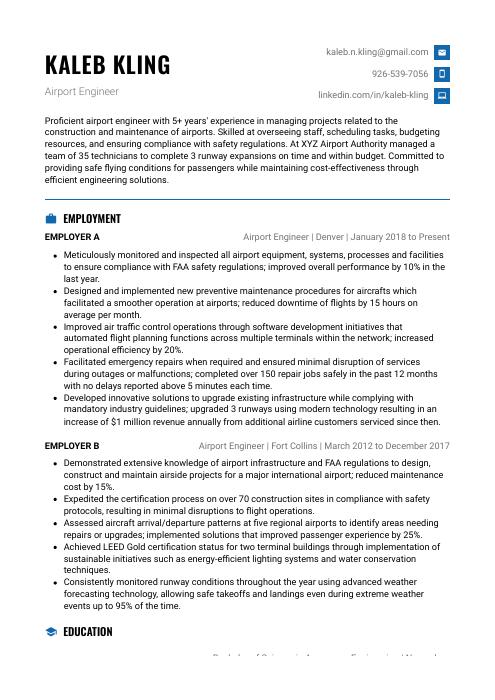 Echidna
Echidna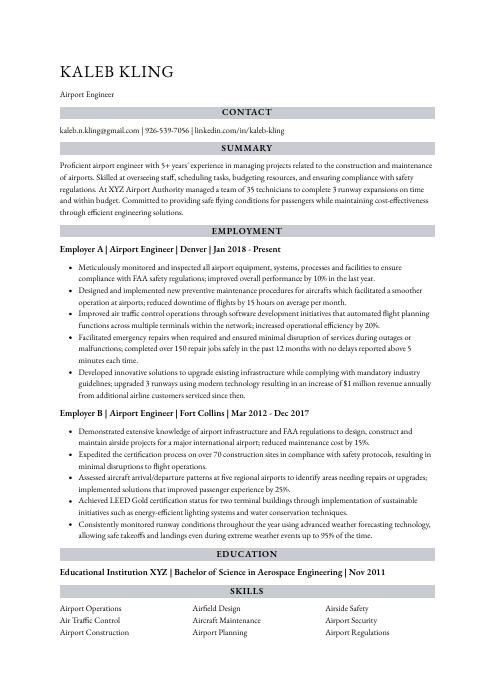 Numbat
Numbat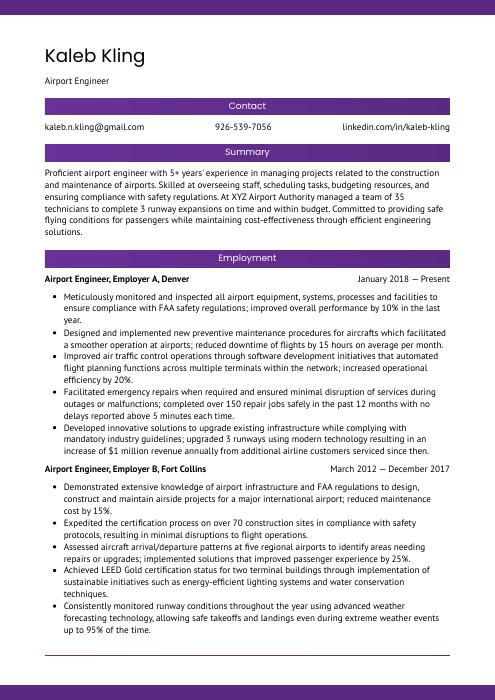 Jerboa
Jerboa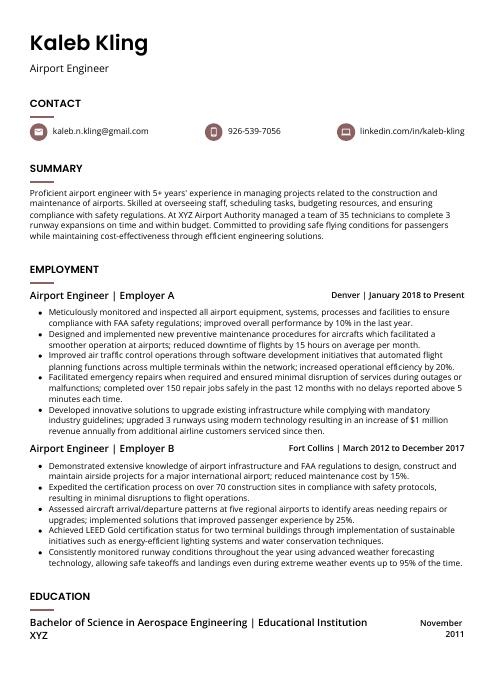 Fossa
Fossa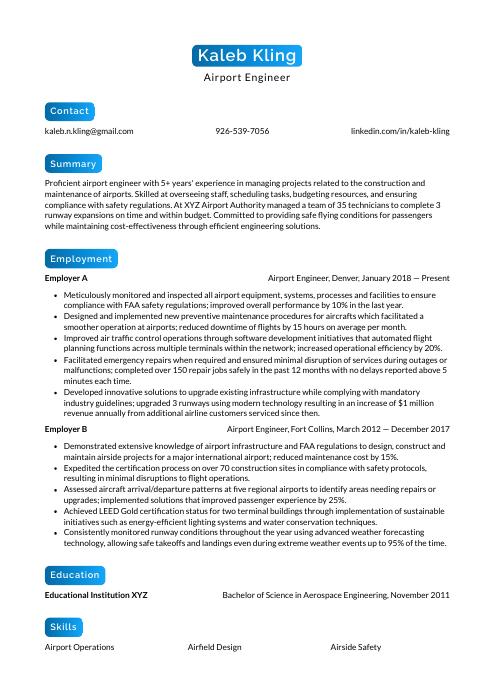 Kinkajou
Kinkajou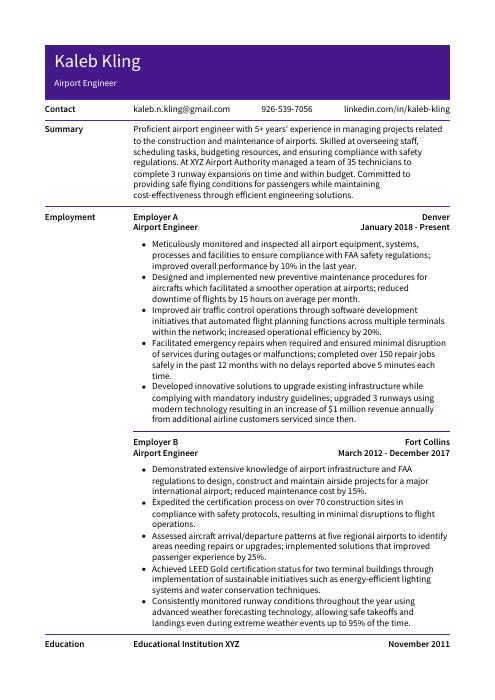 Pika
Pika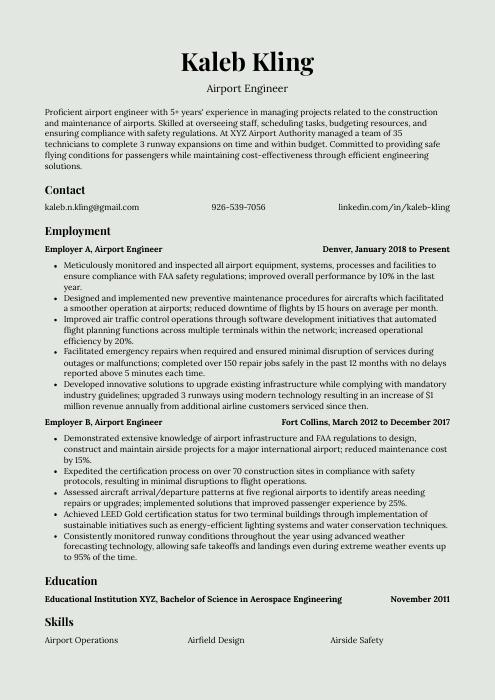 Saola
Saola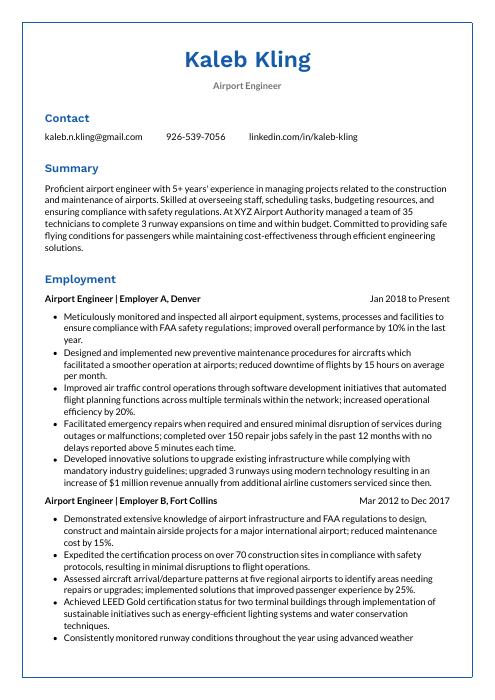 Markhor
Markhor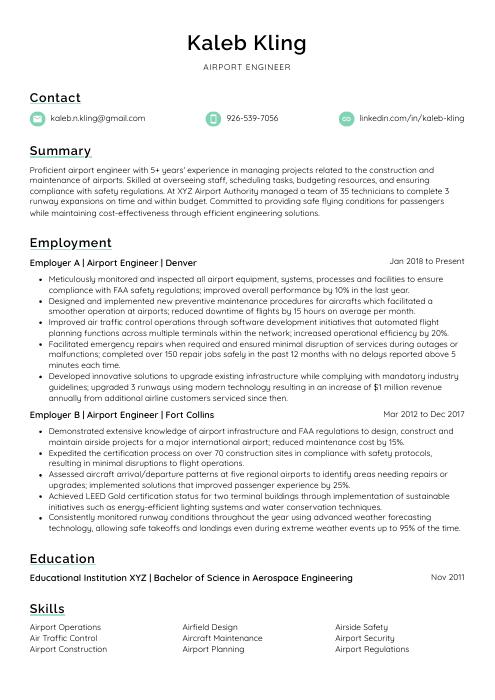 Lorikeet
Lorikeet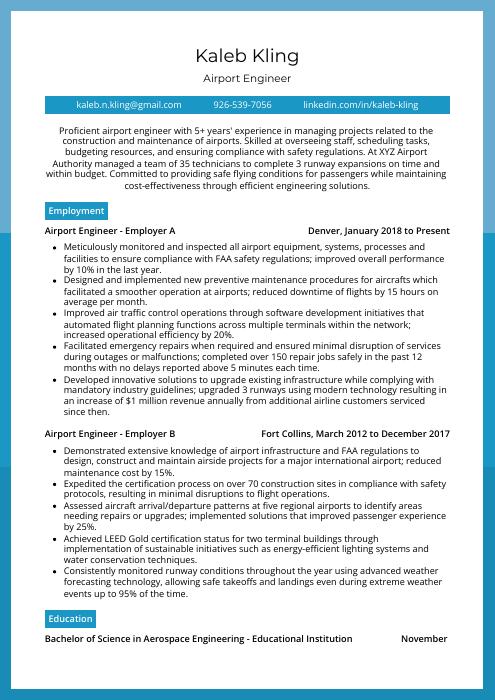 Rhea
Rhea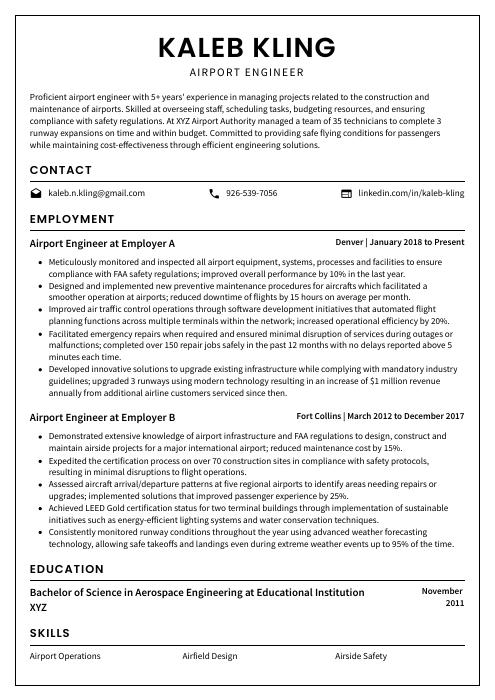 Cormorant
Cormorant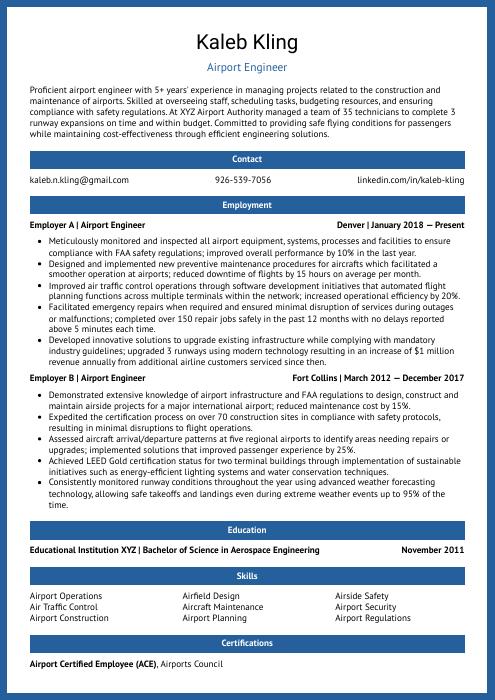 Ocelot
Ocelot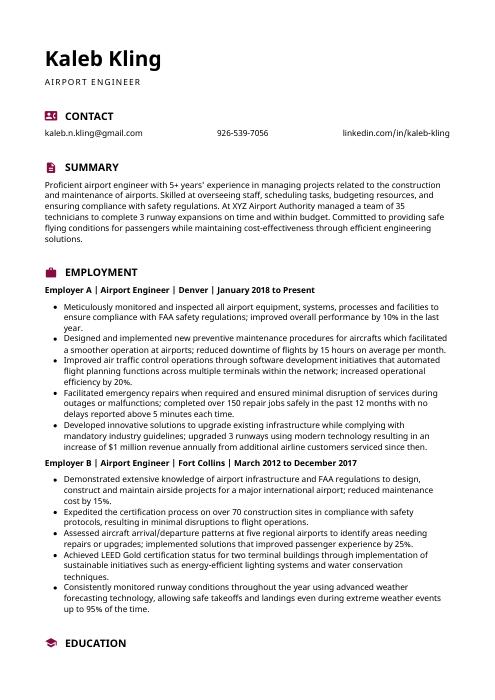 Hoopoe
Hoopoe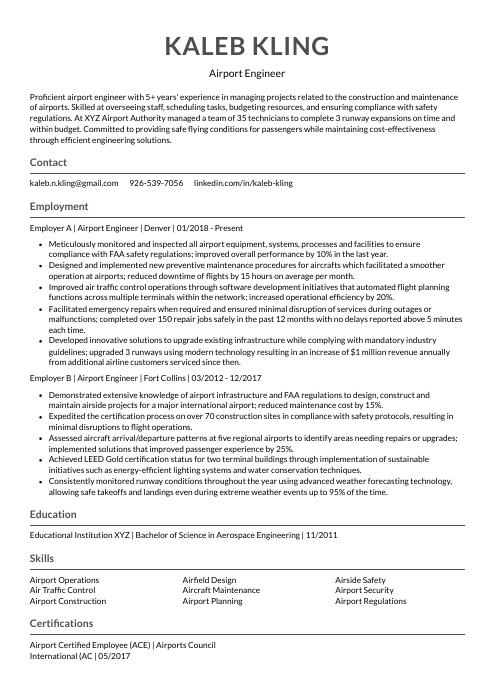 Indri
Indri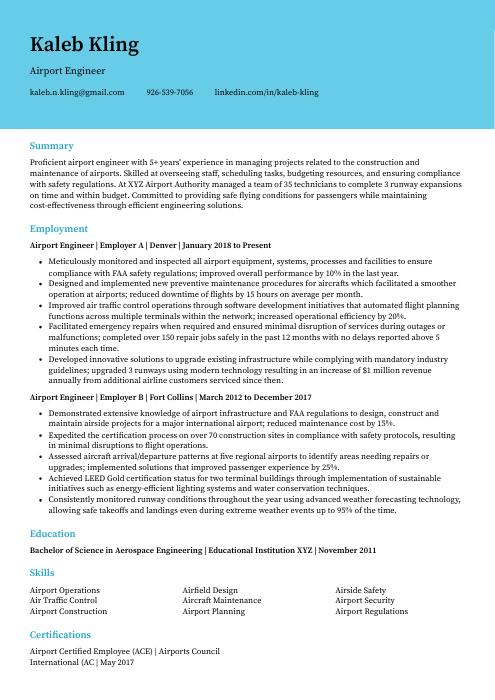 Dugong
Dugong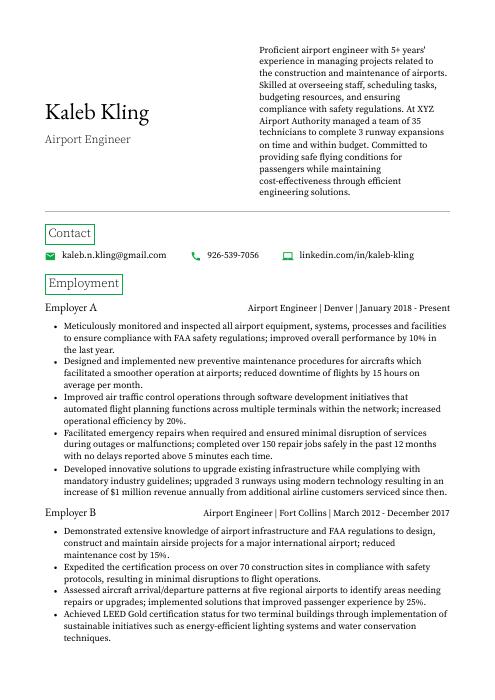 Quokka
Quokka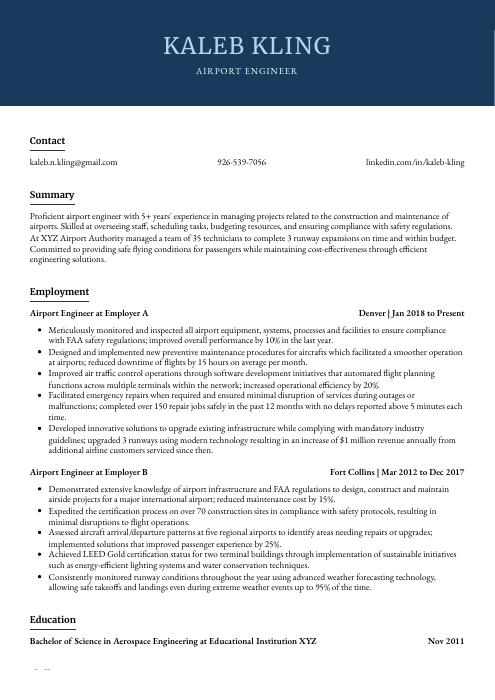 Bonobo
Bonobo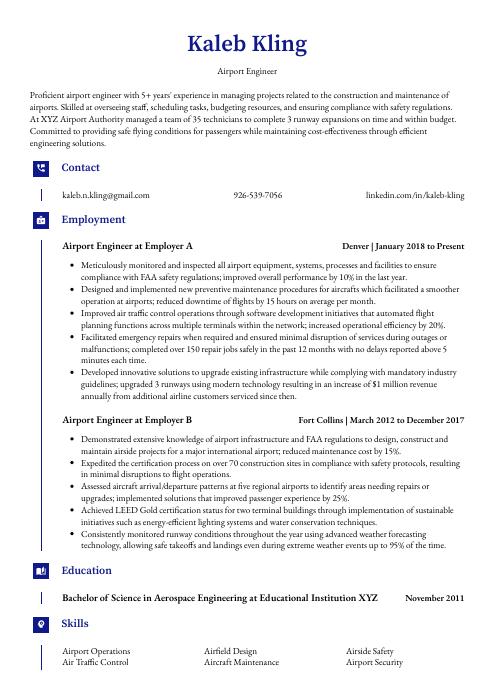 Gharial
Gharial Rezjumei
Rezjumei
